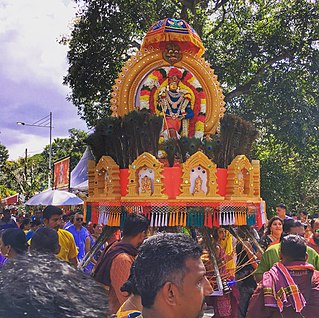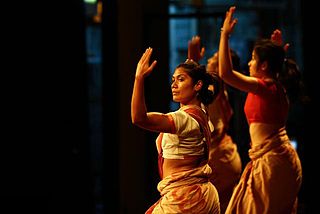
Hinduism in Southeast Asia had a profound impact on the region's cultural development and its history. As the Indic scripts were introduced from India, people of Southeast Asia entered the historical period by producing their earliest inscriptions around the 1st to 5th century CE. Today, Hindus in Southeast Asia are mainly Overseas Indians and Balinese. There are also Javanese and Balamon Cham minority in Cambodia and south central Vietnam who also practice Hinduism.

Thaipusam or Thaipoosam is a Tamil Hindu festival celebrated on the first full moon day of the Tamil month of Thai coinciding with Pusam star. The festival is celebrated to commemorate the victory of Hindu god Murugan over the demon Surapadman using a vel, a divine spear granted by his mother, Parvati.
Religion in Singapore is characterised by a wide variety of religious beliefs and practices due to its diverse ethnic mix of people originating from various parts of the world. A secular state, Singapore is commonly termed as a "melting pot" of various religious practices originating from different religious denominations around the world. Most major religious denominations are present in the country, with the Inter-Religious Organisation, Singapore (IRO) recognising 10 major religions. A 2014 analysis by the Pew Research Center found Singapore to be the world's most religiously diverse nation.
The Chitty, also known as the Chetty or Chetti Melaka, are a distinctive group of Tamil people found mainly and originally in Melaka, Malaysia, and in Singapore where they migrated to in the 18th and 19th centuries from Melaka, who are also known as the "Indian Peranakans" and have adopted Malay (mostly) and Chinese cultural practices whilst also retaining their Hindu faith and heritage. In the 21st century, their population stands at 2,000. The Chitty/Chetti community or Chettiar community, is from South India and are devout Hindus.

Indian Singaporeans are Singaporeans of Indian or of general South Asian ancestry. They constitute approximately 9.0% of the country's citizens, making them the third largest ancestry and ethnic group in Singapore.

Hinduism is the fourth-largest religion in Malaysia. About 1.78 million Malaysian residents are Hindus, according to 2010 Census of Malaysia. This is up from 1,380,400 in 2000.

Hinduism is the Fourth-largest religion in Myanmar, being practised by 1.7% of the population of Myanmar. Hinduism is practised by about 890,000 people in Myanmar, and has been influenced by elements of Buddhism, with many Hindu temples in Myanmar housing statues of the Buddha. There are also a large population of Hindus in which the Myanmar Tamils and minority Bengali Hindus having the biggest population share.

Hinduism in Thailand is a minority religion followed by 84,400 (0.1%) of the population as of 2020. Despite being a Buddhist-majority nation, Thailand has a very strong Hindu influence. The majority of Thai Hindus reside in Bangkok, Chonburi, and Phuket.

The Tamil diaspora refers to descendants of the Tamil speaking immigrants who emigrated from their native lands in the southern Indian subcontinent to other parts of the world. They are found primarily in Malaysia, Arab states of the Persian Gulf, South Africa, North America, Western Europe, and Singapore. It can be divided into two main diasporic clusters, due to geographical, historical and cultural reasons, as Indian Tamil diaspora and Sri Lankan Tamil diaspora.

The Sri Mahamariamman Temple is the oldest Hindu temple in Kuala Lumpur, Malaysia. Founded in 1873, it is situated at the edge of Chinatown in Jalan Bandar. In 1968, a new structure was built, featuring the ornate 'Raja Gopuram' tower in the style of South Indian temples.

The Arulmigu Sri Mahamariamman Temple is a Hindu temple within George Town in the Malaysian state of Penang. The oldest Hindu temple in the state, it was built in 1833, and features sculptures of gods and goddesses over its main entrance and facade.

The Hindu Endowments Board (HEB) is a statutory board under the Ministry of Culture, Community and Youth (MCCY) in Singapore.
The history of Singaporean Indians refers to the pattern of ethnic Indian migration and settlement in Singapore from 1819 to the present day. It also includes the social and political history of the Indian community in Singapore during this period.

Sri Maha Mariamman Temple, also known as Maha Uma Devi Temple (Thai: วัดพระศรีมหาอุมาเทวี; RTGS: Wat Phra Si Maha Umathewi and Wat Khaek in Thai, is a South Indian architecture style Hindu temple on Si Lom Road in Bangkok, Thailand. It was built in 1879 by Vaithi Padayatchi, a Tamil Hindu immigrant.

Malaysian Indians or Indian Malaysians are Malaysian citizens of Indian or South Asian ancestry. They now form the third-largest group in Malaysia, after the Malays and the Chinese. Most are descendants of those who migrated from India to British Malaya from the mid-19th to the mid-20th centuries. Most Malaysian Indians are ethnic Tamils; smaller groups include the Malayalees, Telugus and Punjabis. Malaysian Indians form the fifth-largest community of Overseas Indians in the world. In Malaysia, they represent the third-largest group, constituting 7% of the Malaysian population, after the ethnic Malays and the Chinese. They are usually referred to simply as "Indians" in English, Orang India in Malay, "Yin du ren" in Chinese.

Kampung Madras, formerly known as Kampung Keling, is the Little India of Medan, Indonesia, and one of the city's significant ethnic enclaves. Kampung Madras encompasses an area of approximately 10 hectares, and hosts a large Indian. Now a now part of the Medan Polonia district, Kampung Madras is home to many sporting goods resellers, sari stores, and other shophouses.
The Hindu Mahajana Sangam is an association of Indian workers. It is one of the Indian non-profitable organization at Penang, Malaysia which has been officially established in 1935 by waterfronts workers. Before 1935, it known as Kootakkadai .

Hinduism in Vietnam is mainly observed by the Balamon Cham people in Vietnam. Balamon Cham are one of the two surviving non-Indic indigenous Hindu people. According to the 2022 US State Department Report, there are 70,000 Hindus living in Vietnam today.

Malaysian Malayalees, also known as Malayalee Malaysians, are people of Malayali descent who were born in or immigrated to Malaysia from the Malayalam speaking regions of Kerala. They are the second largest Indian ethnic group, making up approximately 15% of the Malaysian Indian population. The bulk of Malaysian Malayali migration began during the British Raj, when the British facilitated the migration of Indian workers to work in plantations, but unlike the majority Tamils, the vast majority of the Malayalis were recruited as supervisors in the oil palm estates that followed the kangani system, and some were into trading and small businesses with a significant proportion of them running groceries or restaurants. Over 90% of the Malayalee population in Malaysia are Malaysian citizens.






















